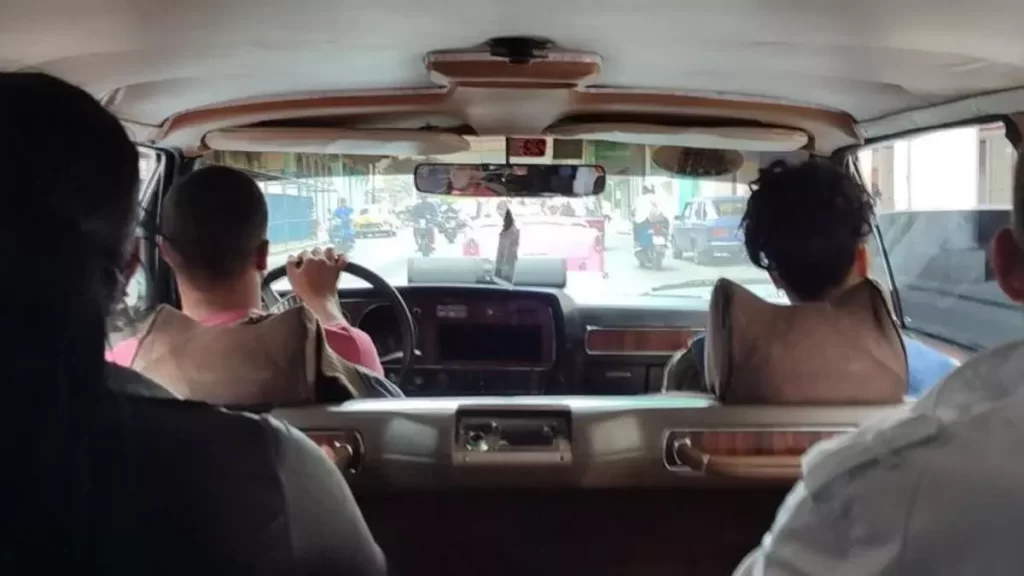
![]() 14ymedio, Natalia López Moya, Havana, 21 February 2024 — It was one of the fleet of GAZ 14 Chaika cars that Leonid Brezhnev gave to Fidel Castro in the 1970s. Now, it serves as a collective taxi like any old almendrón* and travels the route between the Parque de la Fraternidad and Santiago de las Vegas, in Havana. “Since there is no tourism and we have to put food on the table, the Cubataxi company has us picking up the fares,” says the driver this Wednesday, while transporting five customers on a cold Havana morning.
14ymedio, Natalia López Moya, Havana, 21 February 2024 — It was one of the fleet of GAZ 14 Chaika cars that Leonid Brezhnev gave to Fidel Castro in the 1970s. Now, it serves as a collective taxi like any old almendrón* and travels the route between the Parque de la Fraternidad and Santiago de las Vegas, in Havana. “Since there is no tourism and we have to put food on the table, the Cubataxi company has us picking up the fares,” says the driver this Wednesday, while transporting five customers on a cold Havana morning.
With a glossy black body and an intimidating length, the Chaika has an adaptation that allows it to carry up to six passengers, in addition to the driver. Where there used to be ample space for travelers to stretch their legs, an improvised seat has been placed such that it requires them to raise their knees.
But even these transgressions do not tarnish its stately bearing and the historical value of the vehicle, a symbol of a time when the Kremlin’s wallet seemed bottomless when it came to propping up the Cuban regime. “This was one of the ones used for Fidel Castro’s bodyguards, that’s why it’s not armored,” adds the driver when asked by a client.
“This was one of those used for Fidel Castro’s bodyguards, that’s why it is not armored”
According to another Cubataxi employee, “Fidel never really liked the Chaikas. He used them for a short time and switched to other capitalist-made cars, which were the ones he preferred,” he says. Of those 15 GAZ cars that the general secretary of the CPSU sent to the island, “there are only about five left circulating on the streets and they are dedicated to tourism, but now almost no foreigners are arriving and we are working with Cubans.”
The so-called Soviet limousines were widely used at the time as protocol vehicles to transport important visitors arriving to the Island. Presidents, high diplomats and political allies traveled in those cars that demonstrated the proximity between the Kremlin and Revolution Square. When they began to provide services to tourism, travelers went crazy to take pictures with those fossils from the Cold War.
The enthusiasm was not shared by Castro. “The first cars he had in 1959 were Oldsmobiles for him and his entourage, then the Alfa Romeos arrived. He rode in the Chaikas for very little time just to please the bolos, the gossipers, and finally he opted for the Mercedes-Benz, “adds this employee who, before Cubataxi, worked in the protocol service of the Council of State.
“Most of the people who get into these Chaikas now don’t know anything about their history, they think they are old cars like any other. But nothing like that, this is as tough as a Chevrolet but it is exclusive because there are very few left and everyone who sat in those seats was a minister or higher,” he says. “People, when they find out where a car like this comes from, scoff and say it’s an almendrovich*, but this is a piece of history, a museum piece with wheels.”
*Translator’s note: Classic American cars are called ‘almendrones‘ in Cuba, a reference to their ‘almond’ shape’, and are used largely as shared taxis. ‘Almendrovich‘ is an additional play on words for these ‘Russian’ almendrones.
____________
COLLABORATE WITH OUR WORK: The 14ymedio team is committed to practicing serious journalism that reflects Cuba’s reality in all its depth. Thank you for joining us on this long journey. We invite you to continue supporting us by becoming a member of 14ymedio now. Together we can continue transforming journalism in Cuba.
